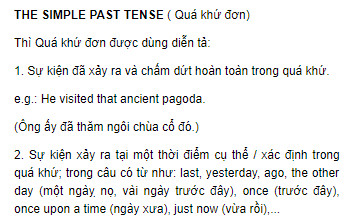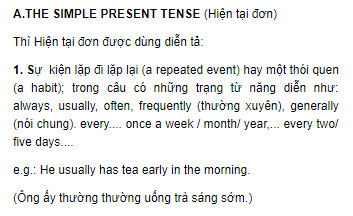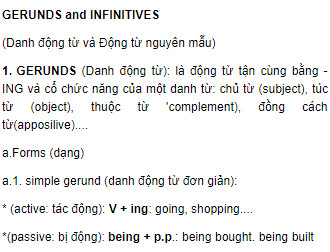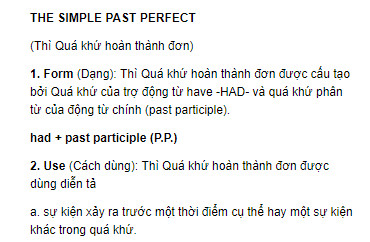
Listening - Unit 16 trang 171 SGK Tiếng Anh 10
Listen and choose A, B, or C that best completes the sentence. (Nghe và chọn A,B hoặc C điền đúng nhất câu.)
- Bài học cùng chủ đề:
- Writing - Unit 16 trang 174 SGK Tiếng Anh 10
- Language focus - Unit 16 trang 175 SGK Tiếng Anh 10
- Test yourself F trang 178 SGK Tiếng Anh 10
- Ngữ pháp tiếng anh hay nhất
LISTENING
BEFORE YOU LISTEN
Work in pairs. Look at the pictures, then answer the following questions. (Làm việc từng đôi. Nhìn vào các hình, và sau đó trả lời các câu hỏi sau.)
1. What are the names of the places? (Tên của những nơi này là gì?)
2. Which of the place have you been to?
3. Which one would you like to visit most? why?

Answer
1. Picture 1 : Basilica of Notre Dame of Saigon (Vương Cung Thánh Đường Đức Bà Saigon).
Picture 2 : Ha Long Bay
Picture 3 : The Hue Bridge (Cầu Thê Húc) in Ha Noi
Picture 4 : Noon Gate (Ngọ Môn) in Hue Imperial City.
2. I’ve been to the Basilica of Notre
3. I’d like to visit Ngo Mon most because it is the remains of our ancient traditional achitecture.
WHILE YOU LISTEN
Task 1: Listen and choose A, B, or C that best completes the sentence. (Nghe và chọn A,B hoặc C điền đúng nhất câu.)
Click tại đây để nghe:
TAPESCRIPT
The ancient town of Hoi An lies on the Thu Bon river, 30 kilometres south of Da Nang. It was formerly a major trading center in Southeast Asia between 16th and 17th centuries. Hoi An was also an important port for Dutch, Portuguese, Italian, Chinese, Japanese and other merchant vessels from the Far East.
Hoi An is famous for its old temples, pagodas, small tile-roofed houses and narrow streets. All the house were made of wood and their pillars were carved with ornamental designs.
One of the main attractions of Hoi An is the Japanese Covered Bridge, which was built in the 16th century and is still well-preserved. All visitors to Hoi An are recommended a visit to the Assembly Hall of Cantonese Chinese Congregation. This house was built in 1855 and still keeps many precious objects that belonged to the Chinese community of Hoi An. Another attractive address to tourists is Tan Ky House, which was constructed nearly two centuries ago as a house of a Vietnamese merchant. The house now looks almost exactly as it did in the early 19th century.
In recent years, Hoi An has become a popular tourist destination in Viet Nam. In 1999, it was certified by UNESCO as a World Cultural Heritage Site.
Questions
1. Hoi An is located_______ kilometres south of Da Nang.
A. 13
B. 30
C. 16
2. Hoi An used to be an important trading centre _______
A. in Southeast Asia
B. in the 19ltl century
C. in the Far East
3. Hoi An is well-known for its old houses which are________
A. small and thatch-roofed
B. narrow and carved
C. small and tile-roofed
4. The Japanese Covered Bridge was built _______
A. in 1855
B. in the 18,h century
C. in the 16,h century
5. Tan Ky House was built as a__________
A. house for a Chinese merchant
B. meeting hall for the Cantonese Chinese
C. house for a Vietnamese merchant
Answer
1. B 2. A 3. C 4.C 5.C
Task 2: Listen again and answer the following questions. (Nghe lại và trả lời các câu hỏi sau.)
Click tại đây để nghe:
1. Where is the ancient town of Hoi An situated?
2. What was I loi An known as between the 16th and the 17,h centuries?
3. What is it now famous for?
4. What are the old houses in Hoi An like?
5. How old is the Assembly Hall of Cantonese Chinese Congregation?
6. When was Tan Ky House built?
7. What is special about this house?
8. When was Hoi An recognised by UNESCO as a World Cultural Heritage Site?
Answer
1. It lies on the Thu Bon River, 30 km south of Da Nang.
2. It was known as a major trading centre in Southeast Asia between the 16th and 17th centuries.
3. Hoi An is now famous for its old temples, pagodas, small lited-roof houses and narrow streets.
4. They were made of wood and their pillars were carved with ornamental designs.
5. It was built in 1855.
6. It was built nearly two centuries ago.
7. The house now looks almost exactly as it did in the early 19th century.
8. It was in 1999.
AFTER YOU LISTEN
Work in groups. Talk about the ancient town Hoi An. using the following cues. (Làm việc từng nhóm. Nói về phố cổ Hội An, dùng những từ gợi ý sau.)
• its location and roles in the past
• its attractive characteristics at present
• its main tourist attractions and their features
Answer
Hoi An is an ancient town in Ceniral Vietnam after our ancient capital city Hue. It lies on the Thu Bon River and it was the trading centre in Southeast Asia in the 16th and 17th centuries. At present Hoi An is still an attractive tourist destination with its characteristics such old temples, pagodas, small tile-roofed houses and narrow streets.
Its main attractions are old architecture such as the Japanese Covered Bridge, Assembly Hall of Cantonese Chinese Congregation and Tan Ky House.
And one more special feature is all the houses were made of wood and their pillars were carved with ornamental designs.
- Unit 1: a day in the life of..- một ngày trong cuộc sống của...
- Unit 2: school talks - những buổi nói chuyện ở trường
- Unit 3: people's background - lý lịch con người
- Unit 4 :special education - giáo dục đặc biệt
- Unit 5 :technology and you - công nghệ và bạn
- Unit 6: an excursion - một chuyến du ngoạn
- Unit 7: the mass media - phương tiện truyền thông đại chúng
- Unit 8: the story of my village - chuyện làng tôi
- Unit 9 : undersea world
- Unit 10: conservation
- Unit 11 : national parks
- Unit 12: music
- Unit 13: films and cinema
- Unit 14: the world cup
- Unit 15: cities
- Unit 16: historical places
- Tổng hợp từ vựng lớp 10 (vocabulary) - tất cả các unit sgk tiếng anh 10






